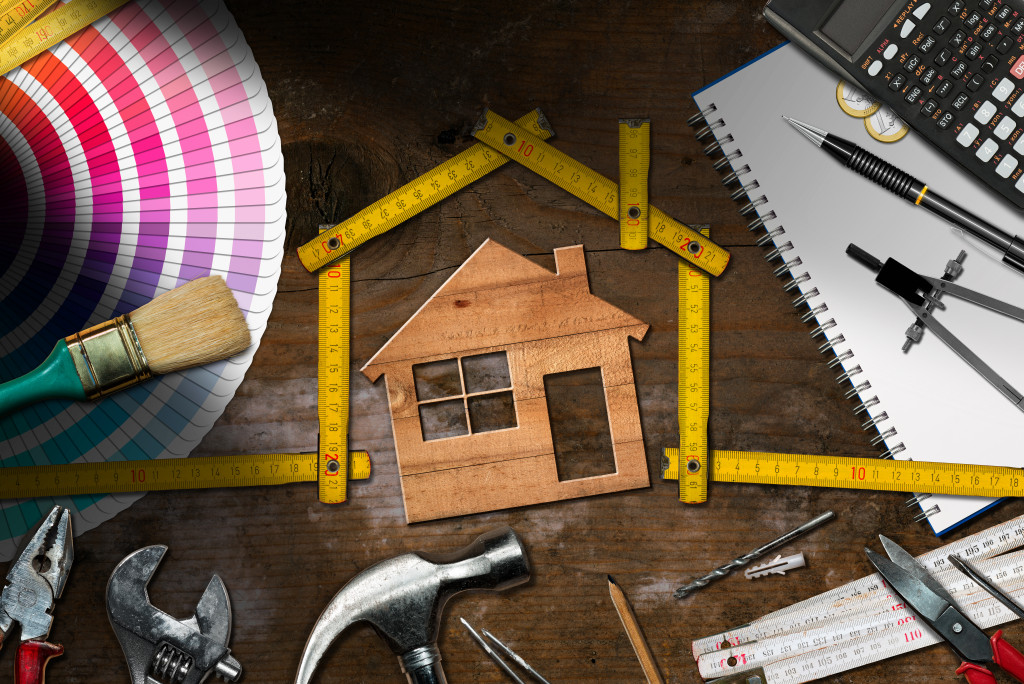- Check your roof and gutters twice a year for any cracks, damages, or leaks.
- Check pipes, faucets, and visible drains for signs of leaks.
- Inspect all wires, switches, and outlets for any signs of damage and contact electrical services immediately.
- Change the HVAC filter every 30 to 90 days and schedule an annual check-up with a professional.
- Prune dead branches or tree limbs twice a year, mow the lawn no more than once a week, spread a layer of mulch, and pull weeds from garden beds.
As a homeowner, one of your primary responsibilities is to keep your home in excellent condition, extend its life, and keep it functional. Whether you just bought your first home or you’ve owned it for years, proper maintenance is crucial. A deteriorating home not only affects your quality of life but can also be costly to repair. The first step in creating a home maintenance plan is to determine what tasks need to be done, how often, and what tools or equipment you’ll need. Below are some of the primary areas to focus on.
Roof and Gutters:
Check your roof and gutters twice a year for any cracks, damages, or leaks. This should be done in the fall and spring after the leaves have fallen and again after the snow has melted.
Make sure to clear out any debris that has accumulated in the gutter. You can do this by hand, or if the debris is too large, you may need to use a trowel or garden rake.
Make sure to wear protective eye gear when working with gutters. This includes gloves, long sleeves, and protective eyewear.

Plumbing:
Periodically check your pipes, faucets, and visible drains for signs of leaks. Fix any leaks immediately.
One of the easiest ways to maintain your plumbing is to pour hot water down the drain to prevent clogging. You can start by running a pot of boiling water into the drain once a month.
Speaking of clogs, it is also important to regularly clean out your drains using a plunger or cleaning solution. A natural vinegar solution or baking soda and salt can help break down grease and grime in the pipes.
Electrical Systems:
Inspect all wires, switches, and outlets for any signs of damage, corrosion, or wear. If you find any issues, contact reliable electrical services immediately.
It’s important to note that under no circumstances should you attempt to repair wires or outlets yourself. This is because it can be dangerous, and you could end up damaging your home even further.
It is also important to check your circuit breaker or fuse box for any tripped breakers or blown fuses. If you find any, reset the breaker or replace the fuse immediately.
HVAC Systems:
Proper maintenance of heating, ventilation, and air conditioning (HVAC) systems can help reduce energy bills and save you money in the long run. Change the HVAC filter every 30 to 90 days, depending on usage, and schedule an annual check-up with a professional.
A check-up typically includes inspecting the system and testing for any leaks or other issues. A professional can help you identify any problems and make necessary repairs before they become more prominent, more expensive issues.
This also has a massive implication on indoor air quality, which is vital for the health of both your family and your home. If possible, invest in a whole-home air purifier to reduce the presence of pollutants and allergens.

Landscaping:
Regular yard maintenance can prevent accidents and damage, so be sure to keep your trees trimmed and hedges trimmed. Here are some easy but effective ways to do so:
Prune Dead Branches or Tree Limbs
When it comes to yard maintenance, pruning dead branches or tree limbs is essential for promoting healthy growth and improving the overall aesthetic of your yard. Pruning should be done twice a year — once in the late winter before new growth begins and again in mid-summer after flowering has ended. This will help to prevent disease, pest infestation, and overgrowth.
Mow the Lawn
Regularly mowing your lawn is important for promoting healthy growth and for creating a neat, clean appearance. Mow the lawn no more than once a week, depending on the weather and frequency of use. Make sure to set the blades at the highest setting when needed to avoid scalping and damaging the turf.
Apply a Layer of Mulch
Mulch helps to insulate the soil, retain moisture, and prevent weed growth. It also adds valuable nutrients back into the ground as it breaks down over time. Spread a layer of mulch around trees, shrubs, flower beds, and other areas of your yard every spring or fall.
Weed Your Garden Beds
Weeds compete with your plants for both sunlight and water, so it’s essential to keep them at bay. Pull weeds from garden beds as soon as you see them, and use a hoe or trowel to get rid of any that have grown too deep. For larger, more stubborn patches of weeds, consider using an herbicide.
Creating a home maintenance plan is essential for keeping your home in good condition, extending its life, and making sure your family stays safe. By following the tips above, you can easily create a plan that fits your needs and budget. Taking care of your home doesn’t need to be complicated or expensive — with regular upkeep and preventative maintenance, you’ll be able to keep your home in top shape for years to come.

